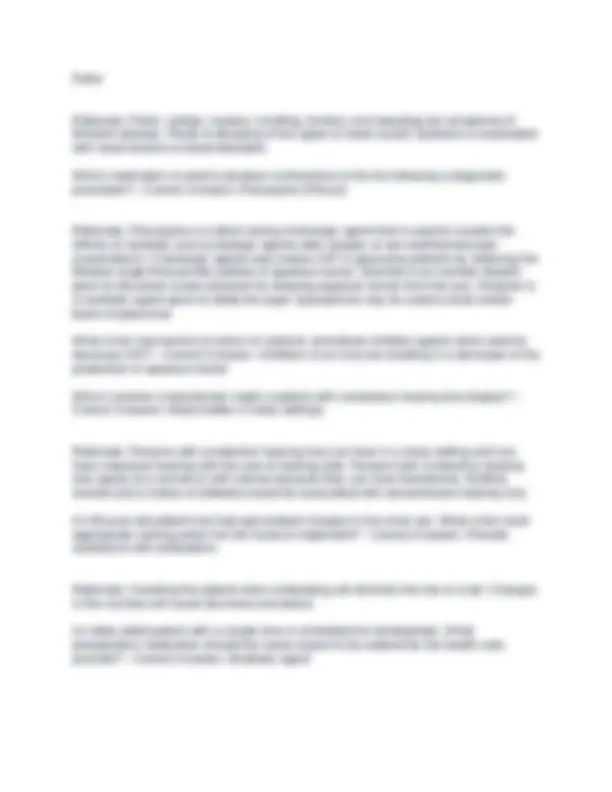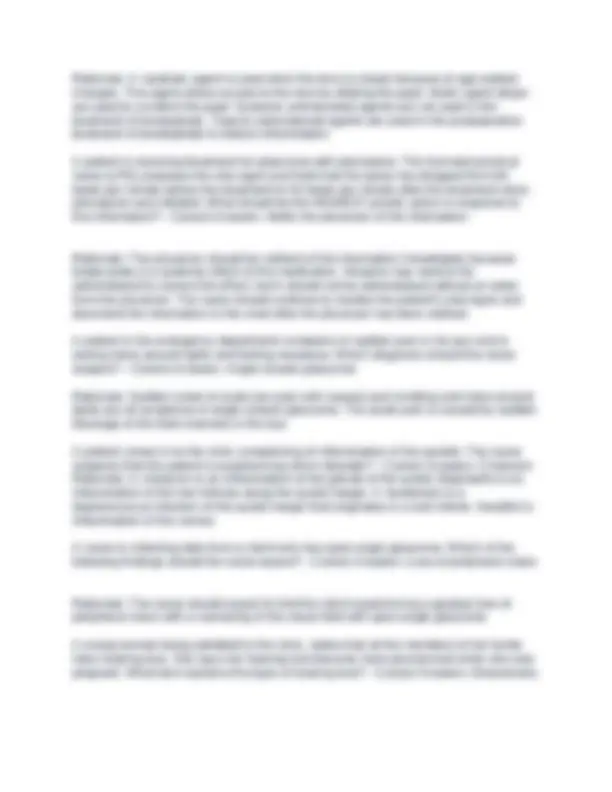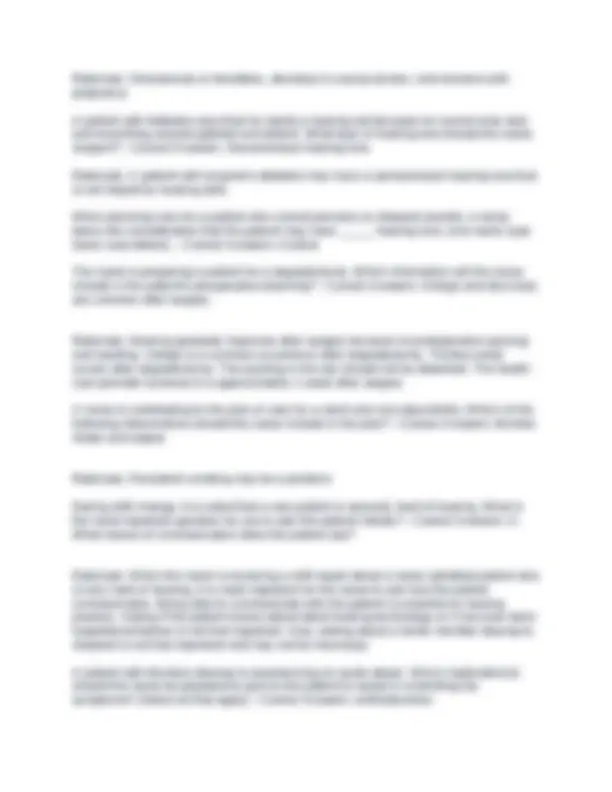





Study with the several resources on Docsity

Earn points by helping other students or get them with a premium plan


Prepare for your exams
Study with the several resources on Docsity

Earn points to download
Earn points by helping other students or get them with a premium plan
Community
Ask the community for help and clear up your study doubts
Discover the best universities in your country according to Docsity users
Free resources
Download our free guides on studying techniques, anxiety management strategies, and thesis advice from Docsity tutors
SENSORY REVIEW QUIZ UNITEK WITH COMPLETE SOLUTIONS
Typology: Exams
1 / 7

This page cannot be seen from the preview
Don't miss anything!




Which is a potential side effect associated with natamycin (Natacyn)? - Correct Answers -Sensitivity to bright light. Rationale: Slight mydriasis is produced allowing excessive light to enter the eyes. The nurse is assisting with tonometry on a patient at the ophthalmologist's office. The results indicate the patient's reading to be 15 mm Hg. The nurse interprets this result as _____ IOP. - Correct Answers -Normal Rationale: Normal IOP using an tonometer is 10 to 20 mm Hg. What is the purpose of administering anticholinergic agents? (Select all that apply) - Correct Answers -Facilitate examination of the eye Perform procedures or surgery on the eye Paralyze ciliary muscle Rationale: The eye is easier to examine in some cases if the ciliary muscle is paralyzed. Surgery on the eye is easier when the ciliary muscle is paralyzed. Cycloplegic agents are used to paralyze the ciliary muscle in preparation for examination or surgery. Drugs that cause pupillary dilation are called mydriatic agents. Cycloplegic agents do not decrease the production of aqueous humor. A nurse assesses an 80-year-old patient for age-related changes to the eye. What potential changes should the nurse anticipate? (Select all that apply) - Correct Answers -Decreased tear secretion Eyeball sunk deep in orbit Hyperopia Arcus senilis
Rationale: Eyelash diminution is not a consistent finding in older adults. All of the other options are common eye changes related to advancing age. What actions should a nurse implement when assessing a patient's visual acuity? (Select all that apply) - Correct Answers -Have the patient stand at a distance of 20 feet away Use a Snellen eye chart Instruct the patient to read down the chart until no more than two mistakes are made on a single line Report the findings as the last line the patient could read with no more than two errors Rationale: Visual acuity is most commonly tested using the Snellen eye chart. Which intraocular pressure reading obtained by tonometry indicates a patient being evaluated for a visual impairment does not have glaucoma? - Correct Answers -18 mm Hg Rationale: The normal intraocular pressure is between 10 and 20 mm Hg. If the patient had glaucoma, the intraocular pressure would be abnormally high. A nurse uses a diagram to show the physiologic sequence of hearing. After entering the external ear, the sound is then conducted through: Arrange the options in the correct sequence (Type in lower case letters, no comma or spaces e.g., abcde ) A. sensory receptors B. tympanic membrane C. oval window D. acoustic nerve to the brain E. malleus, incus, and stapes - Correct Answers -becad A patient with glaucoma is taking a beta-adrenergic blocking agent, timolol (Timoptic). For which potential serious adverse effect should the nurse assess the patient? - Correct Answers -Wheezing Rationale: Beta-adrenergic blocking agents cause bronchospasm and tachycardia. The nurse is caring for a patient with Meniere disease. Which symptoms would the nurse expect to observe in this patient? (Select all that apply) - Correct Answers - Vertigo Tinnitus Hearing loss Nausea
Rationale: A mydriatic agent is used when the lens is cloudy because of age-related changes. This agent allows access to the lens by dilating the pupil. Miotic agent drops are used to constrict the pupil. Systemic antimicrobial agents are not used in the treatment of keratoplasty. Topical corticosteroid agents are used in the postoperative treatment of keratoplasty to reduce inflammation A patient is receiving treatment for glaucoma with pilocarpine. The licensed practical nurse (LPN) assesses the vital signs and finds that the pulse has dropped from 80 beats per minute before the treatment to 52 beats per minute after the treatment when pilocarpine was initiated. What should be the HIGHEST priority action in response to this information? - Correct Answers -Notify the physician of the information. Rationale: The physician should be notified of this information immediately because bradycardia is a systemic effect of this medication. Atropine may need to be administered to correct this effect, but it should not be administered without an order from the physician. The nurse should continue to monitor the patient's vital signs and document the information in the chart after the physician has been notified. A patient in the emergency department complains of sudden pain in his eye and is seeing halos around lights and feeling nauseous. Which diagnosis should the nurse suspect? - Correct Answers -Angle-closure glaucoma Rationale: Sudden onset of acute eye pain with nausea and vomiting and halos around lights are all symptoms of angle-closure glaucoma. The acute pain is caused by sudden blockage of the fluid channels in the eye. A patient comes in to the clinic complaining of inflammation of the eyelids. The nurse suspects that the patient is experiencing which disorder? - Correct Answers -Chalazion Rationale: A chalazion is an inflammation of the glands of the eyelid. Blepharitis is an inflammation of the hair follicles along the eyelid margin. A hordeolum is a staphylococcal infection of the eyelid margin that originates in a lash follicle. Keratitis is inflammation of the cornea A nurse is collecting data from a client who has open-angle glaucoma. Which of the following findings should the nurse expect? - Correct Answers -Loss of peripheral vision Rationale: The nurse should expect to find the client experiencing a gradual loss of peripheral vision with a narrowing of the visual field with open-angle glaucoma A young woman being admitted to the clinic, states that all the members of her family have hearing loss. She says her hearing loss became more pronounced when she was pregnant. What term explains this type of hearing loss? - Correct Answers -Otosclerosis
Rationale: Otosclerosis is hereditary, develops in young women, and worsens with pregnancy A patient with diabetes says that he needs a hearing aid because he cannot hear well, and everything sounds garbled and distant. What type of hearing loss should the nurse suspect? - Correct Answers -Sensorineural hearing loss Rationale: A patient with long-term diabetes may have a sensorineural hearing loss that is not helped by hearing aids. When planning care for a patient who cannot perceive or interpret sounds, a nurse takes into consideration that the patient may have _____ hearing loss. (one word, type lower case letters). - Correct Answers -Central The nurse is preparing a patient for a stapedectomy. Which information will the nurse include in the patient's preoperative teaching? - Correct Answers -Vertigo and dizziness are common after surgery. Rationale: Hearing gradually improves after surgery because of postoperative packing and swelling. Vertigo is a common occurrence after stapedectomy. Tinnitus rarely occurs after stapedectomy. The packing in the ear should not be disturbed. The health care provider removes it is approximately 1 week after surgery A nurse is contributing to the plan of care for a client who has labyrinthitis. Which of the following interventions should the nurse include in the plan? - Correct Answers -Monitor intake and output Rationale: Persistent vomiting may be a problem. During shift change, it is noted that a new patient is severely hard of hearing. What is the most important question for you to ask this patient initially? - Correct Answers -A. What means of communication does the patient use? Rationale: When the nurse is receiving a shift report about a newly admitted patient who is very hard of hearing, it is most important for the nurse to ask how the patient communicates. Being able to communicate with the patient is essential to nursing practice. Asking if the patient knows about latest hearing technology or if has ever been hospitalized before is not that important. Also, asking about a family member staying to interpret is not that important and may not be necessary A patient with Meniere disease is experiencing an acute attack. Which medication(s) should the nurse be prepared to give to the patient to assist in controlling the symptoms? (Select all that apply) - Correct Answers -antihistamines
Rationale: Visual manifestations associated with cataracts can include decreased color perception and decreased visual acuity, even in daylight. A nurse is admitting a client who has a partial hearing impairment. Which of the following actions is the nurse's priority? - Correct Answers -Determine if the client uses a hearing aid Rationale: The first action the nurse should take using the nursing process is to collect data from the client. The nurse should determine if the client uses a hearing aid and if it is in place and functioning to collect data from the client. A nurse is reinforcing teaching with a client who has been newly diagnosed with chronic open angle glaucoma. Which of the following statements by the client indicates an understanding of the teaching? - Correct Answers -"I should call the clinic before taking any over-the-counter medications." Rationale: Taking over-the-counter medications that dilate the pupil could cause the client who has chronic open angle glaucoma to experience an increase in intraocular pressure. The nurse should instruct the client to always check with the provider before using over-the-counter medications. A nurse is reinforcing teaching with a client who has glaucoma. Which of the following statements should the nurse make? - Correct Answers -"Without treatment, glaucoma can cause blindness." Rationale: The nurse should explain that without treatment, glaucoma can result in blindness due to irreversible damage to the retina and optic nerve.